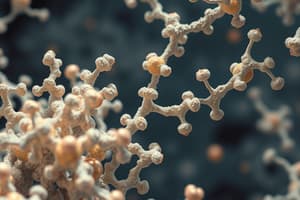Podcast
Questions and Answers
What defines a molecule as a protein?
What defines a molecule as a protein?
- It must be stable at pH 7.
- It must be created through enzymatic processes.
- It must be a polypeptide with more than 40 amino acids. (correct)
- It must contain at least 20 amino acids.
What characteristic do amino acids exhibit at pH 7?
What characteristic do amino acids exhibit at pH 7?
- They are purely hydrophobic.
- They can exist in a non-ionic state.
- They are zwitter ionic. (correct)
- They are only negatively charged.
Which statement best describes the difference between small molecule drugs and proteins?
Which statement best describes the difference between small molecule drugs and proteins?
- Proteins are constructed from amino acids, while small molecule drugs can be made from various organic compounds. (correct)
- Small molecule drugs are always more stable than proteins.
- All proteins act like hormones, whereas small molecule drugs do not.
- Proteins are larger than small molecule drugs and are typically derived from synthetic processes.
Which of the following statements about FDA-approved proteins is true?
Which of the following statements about FDA-approved proteins is true?
Which term describes a molecule that contains both positive and negative charges?
Which term describes a molecule that contains both positive and negative charges?
What is the minimum number of amino acids required for a polypeptide to be classified as a protein?
What is the minimum number of amino acids required for a polypeptide to be classified as a protein?
Which of the following accurately describes the stability issues that proteins might face?
Which of the following accurately describes the stability issues that proteins might face?
Which type of molecule is primarily characterized by its smaller size compared to proteins?
Which type of molecule is primarily characterized by its smaller size compared to proteins?
How many unique variants of peptide bond formation can occur among amino acids?
How many unique variants of peptide bond formation can occur among amino acids?
What unique structural characteristic do amino acids exhibit in solution at neutral pH?
What unique structural characteristic do amino acids exhibit in solution at neutral pH?
Which best illustrates the concept of an amphipathic molecule?
Which best illustrates the concept of an amphipathic molecule?
What is the significance of the number of amino acids in defining a protein?
What is the significance of the number of amino acids in defining a protein?
What role do zwitterionic properties of amino acids at pH 7 play in proteins?
What role do zwitterionic properties of amino acids at pH 7 play in proteins?
How do the structures of proteins differ from those of small molecule drugs?
How do the structures of proteins differ from those of small molecule drugs?
What challenges do formulations for proteins typically face?
What challenges do formulations for proteins typically face?
What defines a protein in terms of its molecular structure?
What defines a protein in terms of its molecular structure?
What type of bonds are primarily responsible for linking amino acids in proteins?
What type of bonds are primarily responsible for linking amino acids in proteins?
Which characteristic distinguishes peptide-based drugs from proteins?
Which characteristic distinguishes peptide-based drugs from proteins?
What is the primary concern regarding the stability of proteins?
What is the primary concern regarding the stability of proteins?
In terms of amino acid structure, what is a significant feature at neutral pH?
In terms of amino acid structure, what is a significant feature at neutral pH?
Which of the following statements about the formulation of proteins is accurate?
Which of the following statements about the formulation of proteins is accurate?
Flashcards are hidden until you start studying
Study Notes
Proteins
- Proteins are made up of amino acids joined together by covalent bonds, these are known as polypeptides.
- Polypeptides with more than 40 amino acids are classified as proteins.
- As of now, over 380 proteins have been approved by the Food and Drug Administration (FDA) and approximately 60 peptide-based drugs are available on the market.
- Amino acids are zwitterionic at pH 7 due to the ionization of both the acid and the amine groups.
- A molecule that carries both positive and negative charges is referred to as amphipathic.
- There are 130 variants of peptide bond formation.
- It is not clearly defined, but proteins consist of more than 40 amino acids.
Proteins - Building Blocks
- Proteins are large molecules composed of amino acids linked together by peptide bonds.
- Proteins are also known as polypeptides.
- A polypeptide with more than 40 amino acids is considered a protein.
- There are currently over 380 FDA-approved protein drugs and 60 peptide-based drugs on the market.
- Amino acids are amphipathic molecules because they contain both positive and negative charges at a pH of 7.
- Amino acids can form up to 130 different peptide bonds.
- There's no definitive definition of a protein, but generally, a polypeptide with over 40 amino acids is considered a protein.
- Amino acids have both hydrophilic (water-loving) and hydrophobic (water-fearing) properties.
Proteins
- Proteins are polypeptides,chains of amino acids linked by covalent bonds.
- Proteins are considered polypeptides with more than 40 amino acids.
- There are currently over 380 FDA-approved protein drugs and 60 peptide-based drugs on the market.
- Amino acids are zwitterionic (have both positive and negative charges) at pH 7 due to the ionization of both the acid and amine groups.
- Zwitterionic molecules with both positive and negative charges are amphipathic.
- There are over 130 variants of peptide bond formation.
- There is no clear definition of the number of amino acids necessary for a polypeptide to be considered a protein, however, proteins typically contain more than 40 amino acids.
Protein Structure
- Proteins are chains of amino acids linked by covalent bonds.
- Proteins have more than 40 amino acids in their chain.
- Amino acids have both positive and negative charges making them amphipathic.
Stability Issues
- Proteins undergo a wide range of different conformations.
- The structure and stability of proteins are affected by pH, temperature, and ionic strength.
Small Molecule vs Protein Drugs
- There is no clear definition, but there are more than 40 amino acids.
- Proteins are often large molecules with complex structures.
- Small molecules tend to be smaller, simpler molecules.
- Currently, there are 380 FDA approved protein drugs.
Formulation Development
- Formulations are developed to protect the physical and chemical stability of proteins.
- Current research is focused on creating stable, safe, and effective protein drugs.
Studying That Suits You
Use AI to generate personalized quizzes and flashcards to suit your learning preferences.




